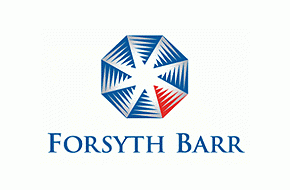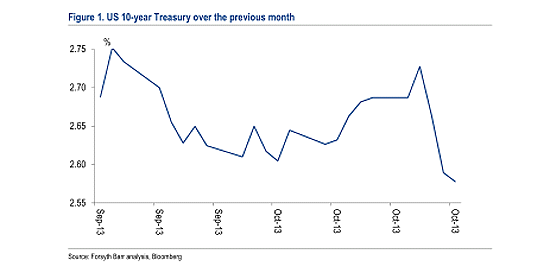
Content supplied by Forsyth Barr
The following is a summary of the key events impacting fixed income markets over the past week.
As we succumb to another temporary solution to the US debt crisis, the attention will remain firmly on the US this week with the delayed non-farm payrolls data finally released. The RBNZ continued its offensive, highlighting the risks surrounding the housing market.
Inflation on the rise
Consumer prices rose 0.9% in the September quarter taking the annual inflation rate to 1.4% and back within the Reserve Bank of New Zealand’s 1% to 3% target band. There is no doubt now that inflation pressures are building with both measures beating the RBNZ’s forecasts released last month.
The area of concern for the RBNZ would be the increase in non-tradable inflation which is more persistent and tends to reflect the domestic conditions. The market continues to price in the first rise in the Official Cash Rate in March 2014. This is no doubt impacting on the NZD which has risen from 0.77 to 0.85 over the last six weeks.
RBNZ reiterate its concerns re: housing market
RBNZ Deputy Governor, Grant Spencer delivered another shot at the housing market and risks to both financial and price stability. The RBNZ appear to be saying (to anyone who will listen) that the supply (lack of houses) and demand (for credit) are issues that cannot be fixed by themselves.
The RBNZ’s macro-prudential tools are designed to target the demand for credit side of the equation, however the RBNZ cannot do much around the supply of housing. The RBNZ must also realise the consequences that if New Zealand (i.e. Auckland) built the amount of houses needed, combined with the Christchurch rebuild, inflation is likely to head much higher. This would in turn see the OCR rise, implying that there is no easy fix to this issue.
The US does it again
Good things come to those that wait, well the world waited and the debt ceiling was raised, albeit temporarily. While equity and bond markets celebrated, the fallout from the debacle in Washington, is likely to see ‘tapering’ be pushed out further into 2014.
It appears March 2014 is the most likely start date for the Fed’s tapering where the Fed’s QEIII purchases may fall to US$70bn per month from the current US$85bn.
Analysts and economists alike are now trying to quantify the cost of the game of chicken which saw the US ‘partially shut-down’ for 16 days. The best guess so far is that it will shave of 0.5% of Q4 GDP.
US unemployment due this week
On Wednesday morning (NZT), the market will receive the unemployment figures for September after they were delayed by the US shut-down. By all accounts the unemployment rate is expected to remain unchanged at 7.3% with the creation of 180,000 jobs expected.
US kicks the debt ceiling can down the road once more
The inevitable happened last week with US politicians completing a last minute deal to starve off a US default - temporarily. There are two interesting factors to look at here; the first is the market reaction to the whole debt ceiling and US shutdown, with the second issue being, what will the reaction be in January/February?
As we mentioned in last week’s report, the US has raised the debt ceiling over 70 times in its history and we have witnesses several US shutdown’s before as well, however are the markets now completely dismissing any possibility of a default? Many would argue that a US default is so far removed from reality that it is not a consideration and they may well be 100% correct, however some of the market reaction to the situation was a touch dismissive.
First of all, we have seen equity markets reach all-time highs due to the debt ceiling being raised and ‘dealt with later’. It is now the assumption that ‘tapering’ will also be delayed. So they equity guys are happy that the US$85bn a month from the Fed may keep rolling in for a while longer, theoretical prompting growth.
If we look back to July 2011, the S&P500 fell ~20% on the debt ceiling saga which saw the US stripped of its AAA credit rating, two years on and faced with the same situation, the S&P500 reaches all-time highs. The bond market was also subdued with the yield on the benchmark 10-year treasury falling just -11bp over the last month.
Compare this to the period leading up to the last debt ceiling saga, July 2011 where the US10-year fell-39bp the month prior to the ceiling being raised.
How will this all end? Everything seems very temporary from the US political agenda to the Fed’s monthly bond purchases. Can the world’s largest economy stand on its own two feet as the mere hint of higher interest rates (already at absurdly low levels) almost sends the US calling for a defibrillator.
Our attention will now shift to 15 January and 7 February (or beforehand if the US politicians decide not to repeat this game) and the market reaction next time around could be even more subdued.

Corporate / Credit news
Contact Energy (CEN) announced it will redeem its subordinated capital bond, CENFA. Under the terms of the issue, CEN has the ability to call the bonds at par plus accrued interest should there be a “rating agency event”. Earlier in the year S&P amended their criteria for high equity content and subsequently, CENFA now only provide 50% equity credit as opposed to the original 100% equity credit. CEN will redeem all CENFA on its next interest payment date 15 November. The last day of trading on the NZDX will be 31 October 2013.
Nufarm (NUF.ASX) reset the coupon on its perpetual preference share. The coupon was reset at 3.9% over the Australian six month bank bill rate. The new distribution rate until April 2014 is 6.5167%.
Origin Energy reset the dividend rate on its perpetual preference share, OCFHA at 1.50% over the prevailing one-year swap rate. The new dividend rate for the year to 17 October 2014 is 4.50%.
Port of Tauranga (POT) launched a wholesale bond offer. The offer of NZ$50m senior, unsubordinated bonds will mature in 29 October 2019 (6 years). POT maintains a BBB+ credit rating from S&P. Minimum denominations are for NZ$500,000 with multiples of NZ$100,000 thereafter.
The Reserve Bank of New Zealand (RBNZ) estimate that the impact from the loan-to-value restrictions will be:
- Mortgage credit growth will be 1% to 3% lower over the first year
- Home sales will be 3% to 8% lower over the first year
- House price inflation will be 1% to 4% lower over the first year.
---------------------------------------------------------------------------------------------------
Disclosures and Disclaimers:
Disclosure: The comments in this publication are for general information purposes only. This publication is not intended to constitute investment advice under the Securities Markets Act 1988. If you wish to receive specific investment advice, please contact your Investment Advisor. Forsyth Barr Limited and its related companies (and their respective officers, agents and employees) may own or have an interest in securities or other products referred to in this publication, and may be directors or officers of, or provide investment banking services to, the issuer of those securities or products, and may receive fees for acting in any such capacity in relation to that issuer. Further, they may buy or sell securities as principal or agent, and as such may undertake transactions that are not consistent with any recommendations contained in this publication. Forsyth Barr Limited and its related companies (and their respective officers, agents and employees) confirms no inducement has been accepted from the researched/recommended entity, whether pecuniary or otherwise, in connection with making any recommendation contained in this publication or on our website.
Analyst Disclosure Statement: In preparing this publication the analyst(s) may or may not have a threshold interest in the securities mentioned in this publication. A threshold interest is defined as being a holder of more than $50,000 or 1% of the securities on issue, whichever is the lesser. In preparing this publication non-financial assistance may have been provided by the entity being researched. A disclosure statement is available on request and is free of charge.
Disclaimer: This publication has been prepared in good faith based on information obtained from sources believed to be reliable and accurate. However, that information has not been independently verified or investigated by Forsyth Barr Limited. Accordingly, Forsyth Barr Limited: (a) does not make any representation or warranty (express or implied) that the information is accurate, complete or current; and (b) excludes and disclaims (to the maximum extent permitted by law) any liability for any loss which may be incurred by any person as a result of that information being inaccurate or incomplete in any way or for any reason. The information, analyses and recommendations contained in this publication are confidential to the intended recipients and are statements of opinion only. They have been prepared for general information purposes and whilst every care has been taken in their preparation, no warranty or representation is given (express or implied) as to their accuracy or completeness. Nothing in this publication should be construed as a solicitation to buy or sell any security or other product, or to engage in or refrain from doing so or engaging in any other transaction. This publication should not be used as a substitute for specific advice. This publication is intended to provide general securities advice only, and has been prepared without taking account of your objectives, financial situation or needs, and therefore prior to acting on any information, analysis or recommendation contained in this publication, you should seek advice from your usual Investment Advisor. Forsyth Barr Limited and its related companies (and their respective officers, agents and employees) will not be liable for any loss whatsoever suffered by any person relying upon any such information, analysis or recommendation. This publication is not intended to be distributed or made available to any person in any jurisdiction where doing so would constitute a breach of any applicable laws or regulations.
We welcome your comments below. If you are not already registered, please register to comment
Remember we welcome robust, respectful and insightful debate. We don't welcome abusive or defamatory comments and will de-register those repeatedly making such comments. Our current comment policy is here.